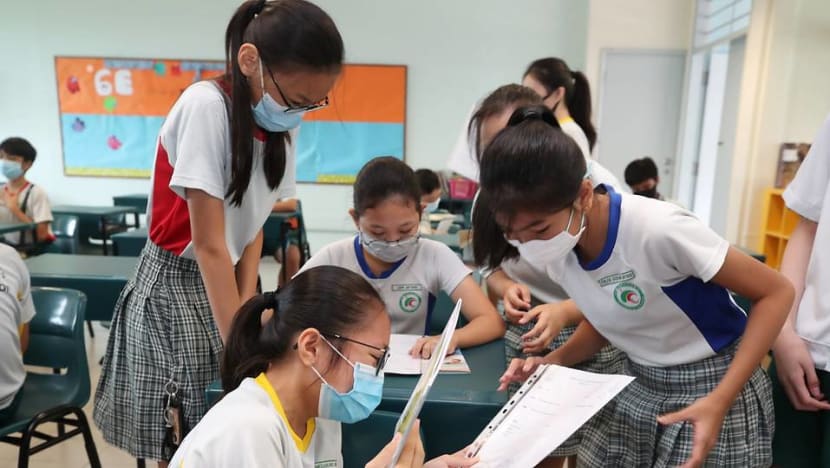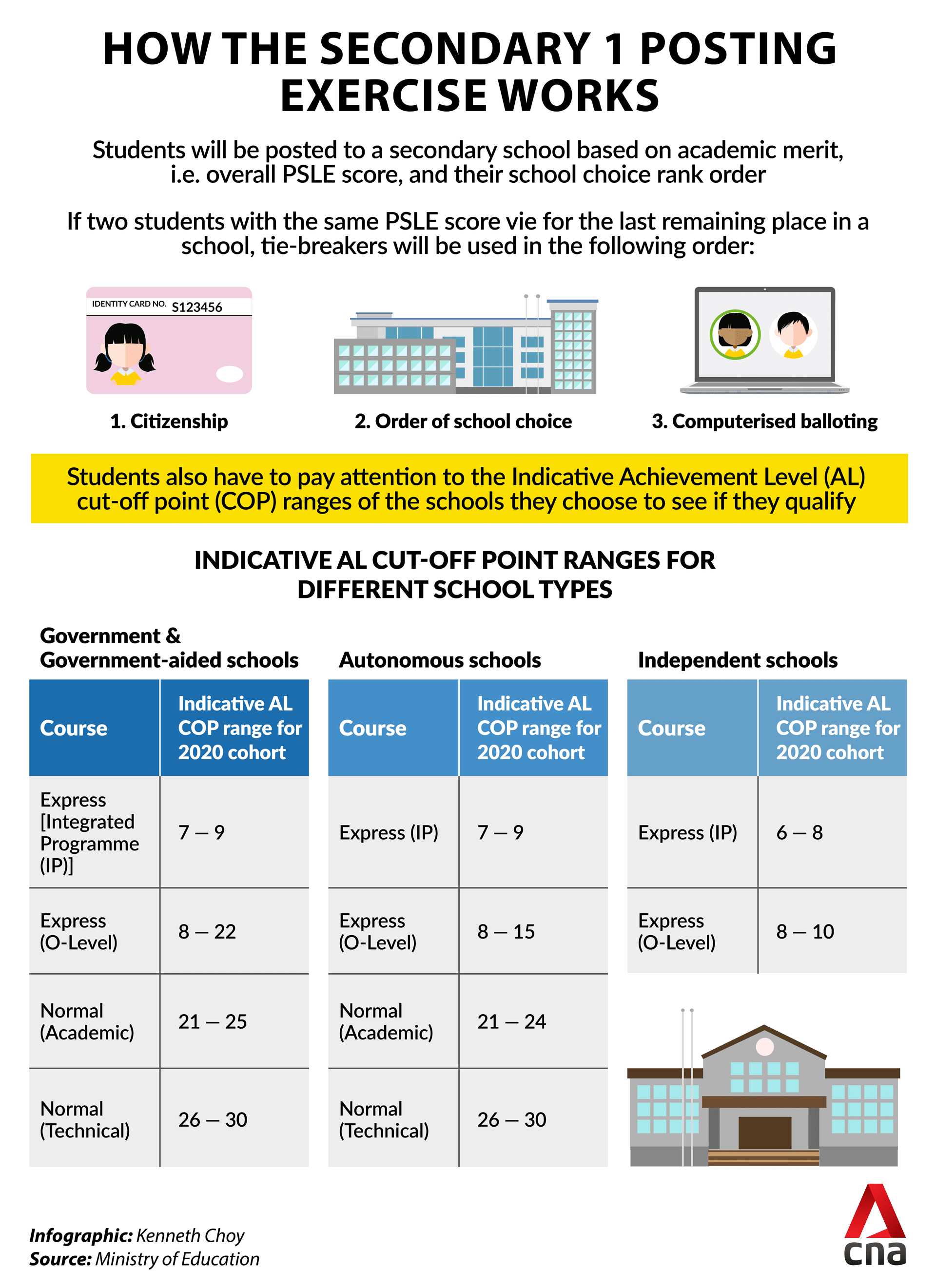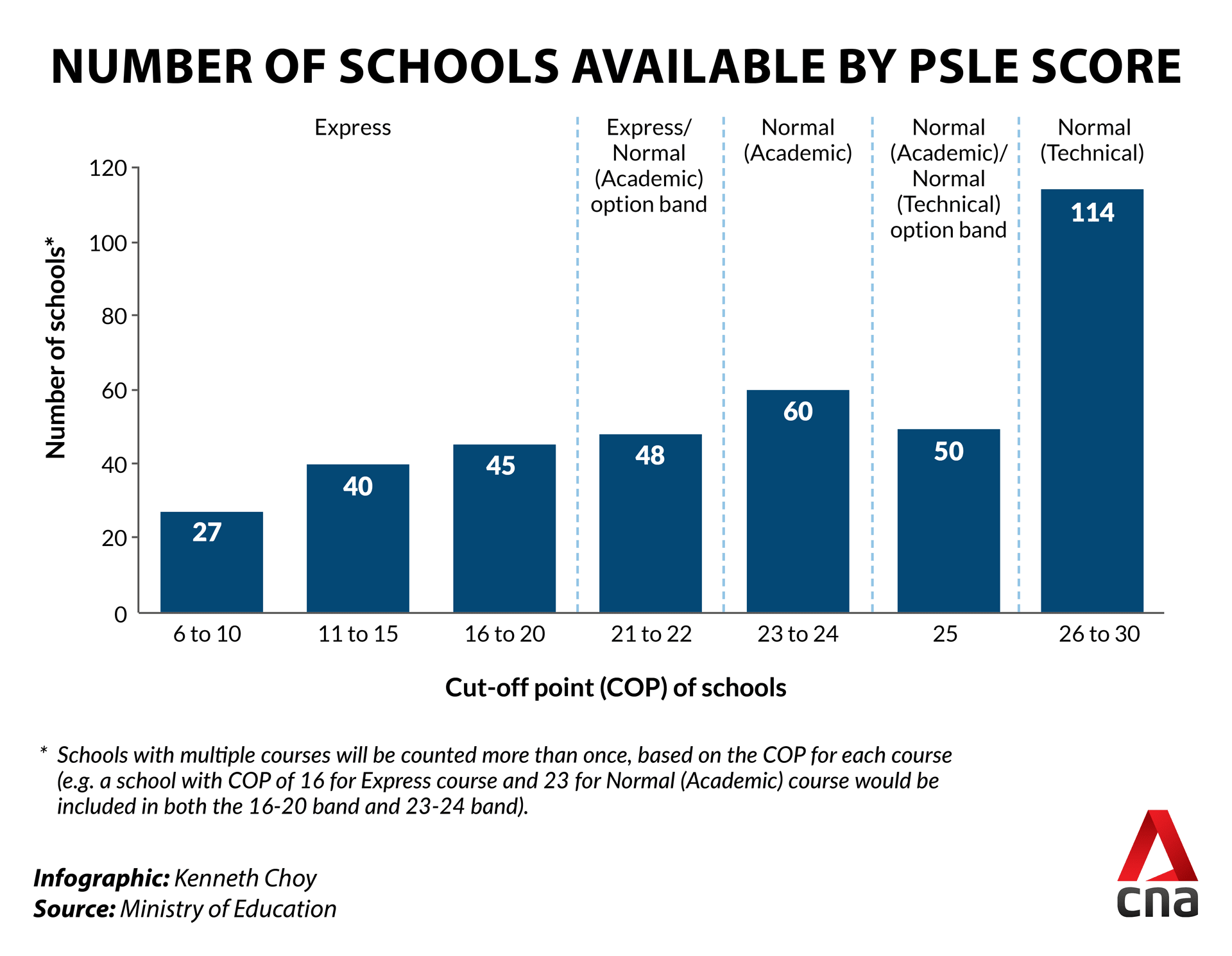FAQ: What you should know about the PSLE scoring system and cut-off points for secondary schools

Students at Northoaks Primary School collect their PSLE results on Nov 25, 2020. (Photo: Facebook/Lee Hsien Loong)
SINGAPORE: The Ministry of Education (MOE) on Tuesday (Apr 27) released the range of scores for entry to nearly 140 secondary schools, under a new scoring system that takes effect this year.
Primary 6 students taking the Primary School Leaving Examination (PSLE) will receive Achievement Levels of 1 to 8 for each of their four subjects, with 1 being the best and 8 the worst.
Their final PSLE score is the sum of these achievement levels - meaning the best possible total score is 4.
Here’s what you need to know about the new PSLE scoring system and what the indicative cut-off points mean for parents and students:
Q: How were the indicative PSLE score ranges for individual schools simulated?
A: The indicative scores are the scores of the first and last student who would be admitted into each school under the new scoring system, based on the 2020 cohort's results and school choice patterns.
The PSLE score of the last student is referred to as the school’s cut-off point.
The indicative score range for Cedar Girls Secondary School, for instance, is 4-8.
MOE first simulated each student’s individual subject score in terms of the Achievement Level based on their raw subject scores. The Achievement Level scores were then added to form a student’s total PSLE score.
Using these simulated PSLE scores and the school choices of the 2020 batch, MOE simulated the students’ posting outcomes based on the new Secondary 1 posting system and the tie-breakers in order of citizenship, choice order of schools and computerised balloting.
The actual PSLE score range is not pre-determined and may vary from year to year depending on that year’s PSLE results and school choice patterns of each Primary 6 cohort.

Q: If my child meets the school’s indicative cut-off point, does that guarantee my child’s admission into the school?
A: Meeting the indicative cut-off point of the school does not guarantee a child’s admission into that school.
The indicative cut-off point is the score of the last student admitted into the school of the previous cohort, and actual cut-off points may vary from year to year.
If there are two or more students with the same PSLE score vying for the last places in the school, a tie-breaker will be applied in the order of citizenship, school choice order and computerised balloting.
"Given this, it is possible for students scoring at the cut-off point of the school to be tie-broken out," said MOE.
Q: Why is there no school with an indicative cut-off point of 4 or 5 in the indicative PSLE score ranges?
A: The indicative PSLE score range of a school shows the score of the first and last student admitted into that school and course in the previous year via the Secondary 1 posting exercise. The score of the last student is the indicative cut-off point of that school.
Based on MOE’s simulations of the 2020 Secondary 1 posting exercise, there were no schools where the last student admitted had a PSLE score of 4 or 5, and therefore no schools with cut-off points of 4 or 5.
Q: What does MOE mean when it says "students have a range of schools to choose from at each PSLE score"?
A: There is a “good spread” of schools with cut-off points at every PSLE score from 6 to 30, said the Education Ministry.
“This means that students would have a range of school options at each PSLE score and could also consider schools with cut-off points that do not correspond exactly to their PSLE scores,” MOE said in a factsheet.
To illustrate, a student with a PSLE score of 6 could choose schools with a cut-off point of 6, 7 or higher.
“We encourage parents and students to look beyond the schools’ cut-off points when choosing a secondary school, and to consider schools that would be a good fit for the student’s overall learning needs.
"This includes choosing schools based on their programmes or initiatives, co-curricular activities, ethos and culture as well as home-school distance,” said the Education Ministry.

Q: Why do several schools have the same indicative cut-off point? How should parents and students choose a secondary school when the indicative cut-off points for many schools are the same?
A: With the new scoring system, PSLE scores are now less finely differentiated - there are only 29 possible PSLE scores compared to more than 200 aggregate scores under the previous T-score system. This means that schools are now less differentiated by cut-off points, said MOE.
“We encourage parents and students to look beyond the schools’ cut-off points when choosing a secondary school, and to consider schools that would be a good fit for the student’s overall learning needs,” said the Education Ministry in the factsheet.
“They should consider the student’s learning needs, interests, strengths and aspirations, and how the school’s culture, environment, ethos, and programmes can support the student’s development.”

Encouraging parents to find out more about the schools using MOE’s platforms like the PSLE-FSBB microsite and SchoolFinder programme, the Education Ministry also stressed that the choice order of schools will be a tie-breaker under the new posting system.
“As choice order of schools will be a tie-breaker under the new Secondary 1 posting system, we encourage parents and students to give careful consideration to the choices that they indicate on the S1 Option Form and choose schools that are a good fit for the learning needs of the student.”
Parents are also advised to consider at least two to three schools where the student’s PSLE score is better than the school’s cut-off point, the ministry said.
Q: Will there be an increased likelihood of balloting since there are fewer possible PSLE scores and more schools at every score?
A: Students will be posted to schools based on academic merit - the students with the better PSLE score will be admitted before others with poorer scores, MOE said.
If there is more than one student with the same score competing for the last available place in the school, tie-breakers will be applied in this order: Citizenship, school choice order and then computerised balloting.
A Singaporean has the highest priority, followed by a permanent resident and lastly an international student.
With school choice order, students who put the school as their first choice would be admitted over others who put it as their second or third choice.
If citizenship and school choice order are the same, computerised balloting will be used to determine which student will be admitted.
The Education Ministry expects that about nine in 10 students will not need to undergo balloting, and the “vast majority” of students will likely be successfully allocated to one of their six school choices, “comparable” to under the T-score system.
“Parents and students should give careful thought to the choices that they indicate since choice order of schools will be a tie-breaker, after citizenship. We encourage parents and students to look beyond schools’ PSLE Score ranges when choosing a secondary school, and to consider schools that would be a good fit for the student’s overall learning needs.”
The score ranges for each school can be found on https://moe.gov.sg/schoolfinder.














